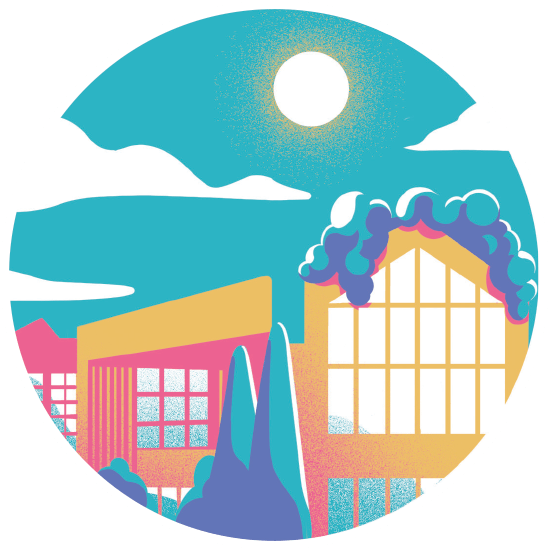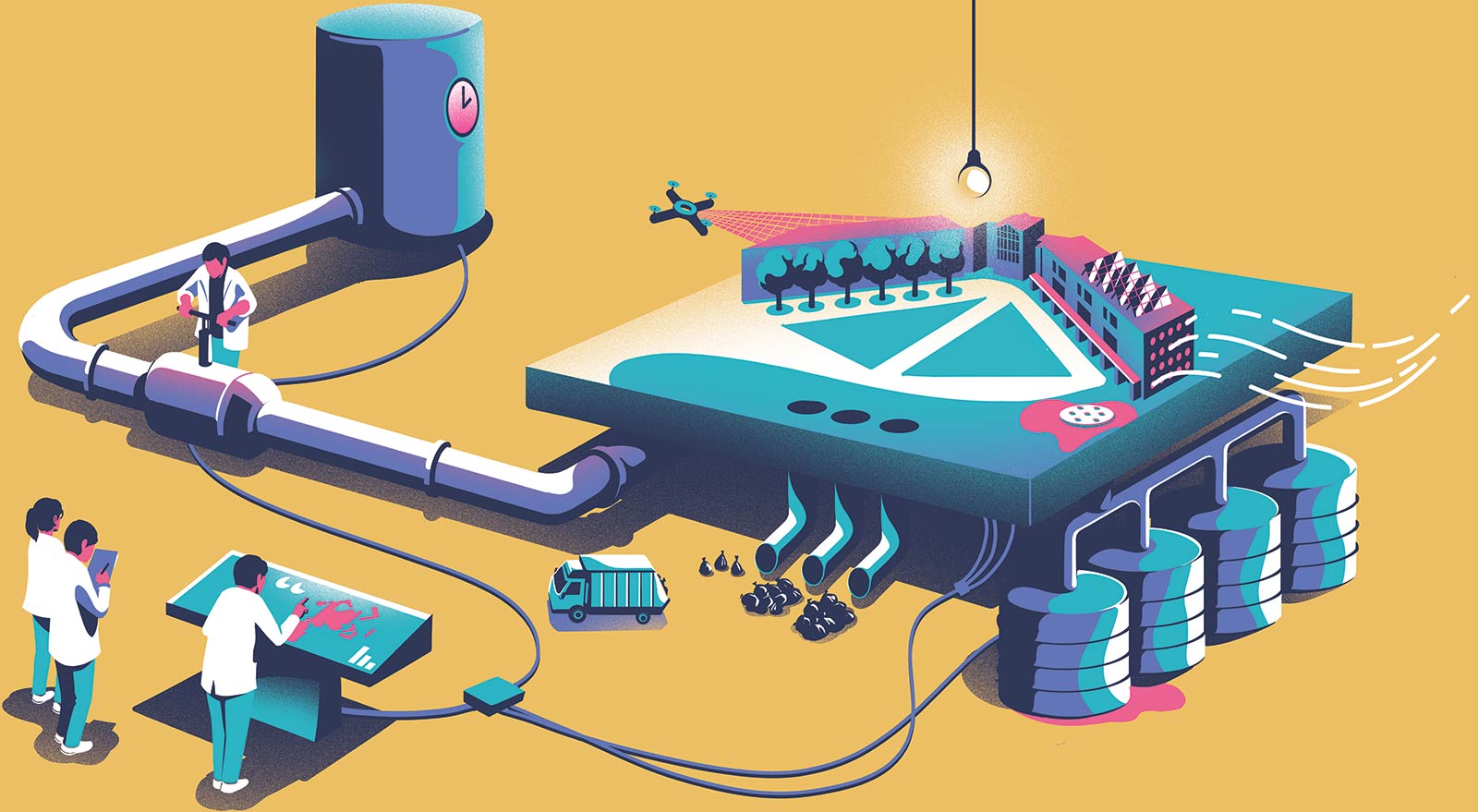
A LEANER, CLEANER, GREENER CAMPUS
A combination of high-tech building mechanization and traditional people power keeps 15,000 daily residents comfortably housed within 16 hectares of interior space at Mount Royal.
Spring/Summer 2017 issue
Supervision of the inner-workings of campus falls under the mandate of the University’s Facilities Management department, which is in charge of a total parcel of land occupying 48 hectares. In 2016, nearly 6,000 requests for service were sent their way, ranging from repairing equipment, to unclogging blocked toilets, to changing burnt-out light bulbs, to adjusting room temperatures. While several needs still require a human touch, Mount Royal is shifting to automating parts of its operations, allowing for the digital modification of some established tools and the installation of new and advanced hardware.
One of the pillars of the University Strategic Plan is to reduce its carbon footprint and overall waste by implementing cutting-edge, energy-saving technology and pioneering recycling initiatives.
Additionally, Alberta’s carbon levy has been estimated (at a high level) to add about $86,000 of cost in 2016/17, $139,000 in 2017/18 and $256,000 in 2018/19, which is providing even more impetus to get the job done well and right.
The driving force behind reaching these goals is Grant Sommerfeld, associate vice-president of Facilities Management. Sommerfeld’s department is tactically moving MRU to be a leader in sustainability amongst post-secondary institutions.
“Not only is it the right thing to do in terms of caring for the environment,” says Sommerfeld, “it also provides the chance to evaluate and streamline our processes, to keep improving on the delivery of our services and to realize the benefits of a triple bottom line.”
Steps have been taken to “green” the campus for several years, but the failure of one of the three exchangers in the University’s heating system in December 2015 presented a unique opportunity.
“When we dug into the root cause, we learned there were worn-out components and no automation, not to mention the equipment was from 1984,” says Owen Zarazun, manager of Building Operations.
Already functioning with reduced capacity to warm water and air, after another exchanger failed in June 2016 it became time to discuss the options. Three new units were installed through October to November, a major project that involved strategic planning, procurement, special ordering (manufacturing), staging, the use of cranes and many person-hours. All this was done without any reduction in service to the campus population.
MRU upgraded to an intelligent boiler management and control system, which is regulated from a touch-screen dashboard that displays all operating parameters, configurations and faults. This front line technology was essentially hard-wired to the existing boiler. With this retrofit, a machine from the 1980s is now performing better than a new install.
MRU is also watching its garbage closely. An extensive waste audit was conducted in 2016 to determine what types of materials were being disposed of on campus.
“This involved sorting and weighing a representative sample of MRU waste,” explains Sommerfeld. “Tearing it apart, spreading it out on a floor, sorting it into its constituent parts and weighing it.
“It was a smelly job that took a lot of expertise.”
It was discovered that roughly 90 per cent of MRU discards do not belong in Calgary’s landfills, says Gerry Young, manager of Environmental Services.
“Education is becoming a bigger part of our waste reduction strategy,” says Young. MRU has implemented awareness campaigns on how to correctly sort waste and placed bins around campus so people can separate their trash into four categories (mixed recycling, refundable, landfill and organic).
“We’re also looking at getting more paper towels from our washrooms into organics,” says Young, as the largest category of discards is paper, representing 40 per cent of the landfill waste stream.
And during the warmer months of the year, organic waste from the kitchens on campus is dehydrated, mulched and used as fertilizer in flower beds, says Sommerfeld.
Facilities Management also provides a yearly sustainability report to the community, and the Sustainable MRU committee keeps the conversation open about how to best manage campus resources.
MRU LEEDS
Leadership in Energy and Environmental Design (LEED) is a third-party certification program and internationally accepted benchmark for the design, construction and operation of high-performance buildings. Every addition to Mount Royal in the last 10 years is LEED Gold accredited, with one small exception being the Science and Technology wing, which is LEED Silver, says Grant Sommerfeld, associate vice-president of Facilities Management.
A recent expansion, the Roderick Mah Centre for Continuous Learning, saves 60 per cent in energy use versus traditional buildings of similar size. It’s situated to maximize natural light and uses infrared radiant panels to heat the interior. A 750,000-litre reservoir in the foundation collects rainwater, which is then treated for contaminants and used for irrigation and sanitation.
The Taylor Centre for the Performing Arts, the next major construction project after the Roderick Mah Centre, features low-flow fixtures that reduce water use by more than 50 per cent, and rainwater collected from the roof is used for washrooms and the cooling tower. For both projects, as much construction waste as possible was removed and recycled.
The Riddell Library and Learning Centre is the next major expansion that will be LEED Gold certified.
“LEED is becoming a lot harder and more expensive to achieve,” says Sommerfeld, “but no buildings will be built at MRU that are not LEED Gold.”
□
Institute for Environmental Sustainability
Networking directly with MRU’s Facilities Management team, the Institute for Environmental Sustainability (IES) was founded in 2013 and aims to improve environmental health through scholarship, integrating a broad range of academic disciplines, student learning and community engagement. The IES works closely with MRU’s Facilities Management team, who are striving to become a STARS (Sustainability Tracking, Assessment & Rating System) ranked University through their membership in the Association for the Advancement of Sustainability in Higher Education (AASHE).
“We are able to conduct multidisciplinary and interdisciplinary research and education around sustainability,” explains Connie Van der Byl, PhD and director of the IES.
“We can often look at what are very complex issues from different perspectives rather than from a siloed approach.”
Operating holistically allows for increased collaboration with external entities, preparing future MRU graduates to enter the workforce with a broad base of knowledge to aid in maintaining a cleaner and greener environment in the years to come.
“We’re doing a scan of all the courses taught at Mount Royal connected to environmental sustainability, and we’re looking at creating a citation wherein students who have a certain number of credits in those courses can then have that noted on their diploma.”
As schools and businesses begin to focus more on reducing their carbon footprint and being good global citizens, careers with an emphasis in this field will become more prevalent.
“One of the immediate career paths in business related to sustainability would be environmental health and safety,” says Van der Byl.
“That typically attracts our science students, where they go out and collect samples and evaluate or monitor the environmental performance of companies. Another area is a sustainability group, which looks at strategic elements of sustainability and policy review, and that draws from business students, science and communications.
“An institution that improves its own footprint, its own sustainability performance, is something that (prospective and current) students are looking for,” says Van der Byl.
“It’s important to this generation.”
Behind the walls, under the floors and overhead
Most of Mount Royal’s environmental efforts happen out of sight, out of mind, but they are managed by a complicated system incorporating machines, manpower, intellect and enterprise.

Read more Summit
The library reimagined
The Riddell Library and Learning Centre is set to open this fall
READ MORE

